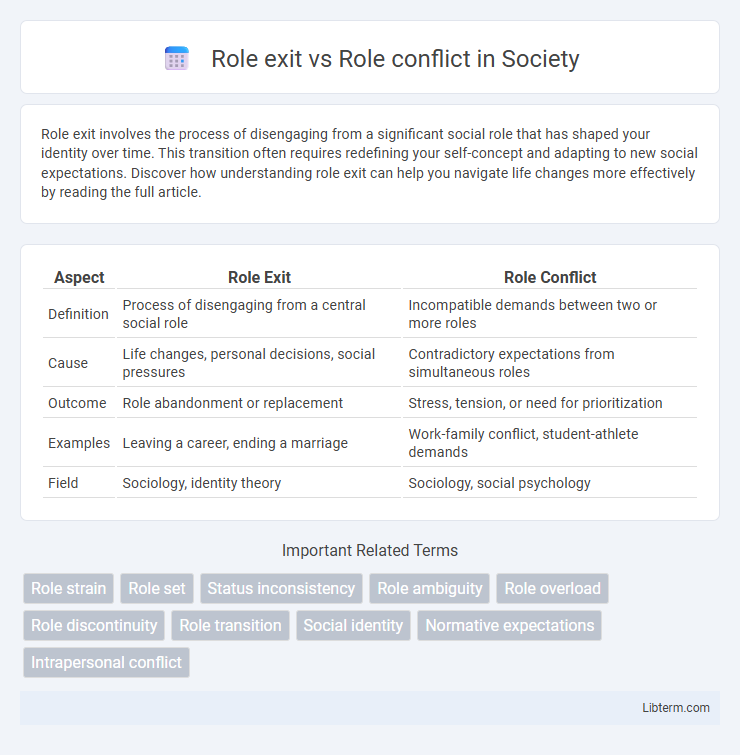Role exit involves the process of disengaging from a significant social role that has shaped your identity over time. This transition often requires redefining your self-concept and adapting to new social expectations. Discover how understanding role exit can help you navigate life changes more effectively by reading the full article.
Table of Comparison
| Aspect | Role Exit | Role Conflict |
|---|---|---|
| Definition | Process of disengaging from a central social role | Incompatible demands between two or more roles |
| Cause | Life changes, personal decisions, social pressures | Contradictory expectations from simultaneous roles |
| Outcome | Role abandonment or replacement | Stress, tension, or need for prioritization |
| Examples | Leaving a career, ending a marriage | Work-family conflict, student-athlete demands |
| Field | Sociology, identity theory | Sociology, social psychology |
Understanding Role Exit: Definition and Process
Role exit refers to the process individuals undergo when disengaging from a significant social role, involving stages such as doubt, seeking alternatives, and establishing a new identity. This process contrasts with role conflict, where competing demands from multiple roles create tension without necessarily leading to leaving a role. Understanding role exit highlights the psychological and social adjustments required to relinquish roles like career, marriage, or parenthood.
What is Role Conflict? An Overview
Role conflict occurs when an individual faces incompatible demands from different social roles, creating tension and stress as they struggle to meet the expectations associated with each role. It often arises in situations where professional responsibilities clash with personal obligations, leading to emotional strain and reduced performance in both areas. Understanding role conflict is essential for organizations and individuals aiming to develop strategies that balance competing demands and enhance overall well-being.
Key Differences Between Role Exit and Role Conflict
Role exit involves the process of disengaging from a central role to establish a new identity, whereas role conflict arises when conflicting expectations from multiple roles create tension for an individual. Role exit typically indicates a transition phase, often marked by emotional and psychological adjustments, while role conflict occurs concurrently as individuals attempt to fulfill incompatible demands across roles. Understanding these distinctions clarifies how social roles impact identity dynamics and stress management.
Psychological Impact of Role Exit
Role exit involves the process of disengaging from a significant social role, often leading to identity confusion, anxiety, and a sense of loss as individuals adjust to new self-conceptions. The psychological impact includes stress, decreased self-esteem, and grief-like symptoms due to detachment from established social networks and routines. Role conflict, by contrast, arises when incompatible demands occur within concurrent roles, generating tension but typically without the profound identity disruption characteristic of role exit.
Causes and Types of Role Conflict
Role exit involves disengaging from a significant social role, while role conflict arises when incompatible demands are imposed by different roles simultaneously. Causes of role conflict include incompatible expectations, resource limitations, and overlapping responsibilities between roles such as employee and parent or student and athlete. Types of role conflict can be inter-role conflict, where two distinct roles clash, and intra-role conflict, which occurs when conflicting demands exist within a single role.
Stages of Role Exit: From Doubt to New Identity
Role exit involves a transformative process beginning with doubt, where individuals question their current role, followed by seeking alternatives and weighing costs before the action stage of role departure. Transitioning into the creation of a new identity, individuals redefine their self-concept and social status as they disengage from old roles. Role conflict, contrastingly, occurs when incompatible expectations arise simultaneously within multiple roles, causing stress without necessarily leading to role abandonment or identity change.
Role Conflict in Family, Work, and Social Settings
Role conflict arises when the demands of different roles, such as those in family, work, and social settings, clash, creating stress and challenges for individuals. In family settings, role conflict often manifests when work responsibilities interfere with parental or spousal duties, leading to strained relationships and emotional tension. In workplace environments, employees struggle to balance professional obligations with social expectations, causing reduced productivity and increased anxiety.
Coping Strategies for Role Conflict
Role conflict arises when incompatible demands are placed on an individual by different roles, causing stress and tension. Effective coping strategies for role conflict include setting clear boundaries, practicing time management, seeking social support, and enhancing communication skills. Utilizing problem-focused coping, such as prioritizing tasks and negotiating role expectations, reduces stress and improves role performance.
Factors Influencing Role Exit Decisions
Factors influencing role exit decisions include personal identity shifts, perceived role strain, and the availability of alternative roles offering greater rewards or satisfaction. Social pressures, such as changing relationships or expectations from significant others, also impact the decision to leave a role. Economic considerations and anticipated future opportunities further contribute to the complexity of exiting a role.
Integrating Insights: Managing Role Exit and Role Conflict
Managing role exit and role conflict involves recognizing overlapping social expectations and the psychological tensions they create. Effective strategies include clear boundary-setting and communication to reduce ambiguity and facilitate smoother transitions between roles. Understanding the dynamics of role disengagement enhances coping mechanisms and supports personal and professional well-being during periods of change.
Role exit Infographic

 libterm.com
libterm.com